
Hard bop is a subgenre of jazz that is an extension of bebop music. Journalists and record companies began using the term in the mid-1950s to describe a new current within jazz that incorporated influences from rhythm and blues, gospel music, and blues, especially in saxophone and piano playing.
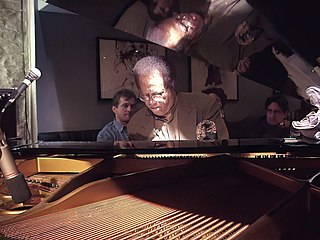
Cedar Anthony Walton Jr. was an American hard bop jazz pianist. He came to prominence as a member of drummer Art Blakey's band, The Jazz Messengers, before establishing a long career as a bandleader and composer. Several of his compositions have become jazz standards, including "Mosaic", "Bolivia", "Holy Land", "Mode for Joe" and "Ugetsu/Fantasy in D".
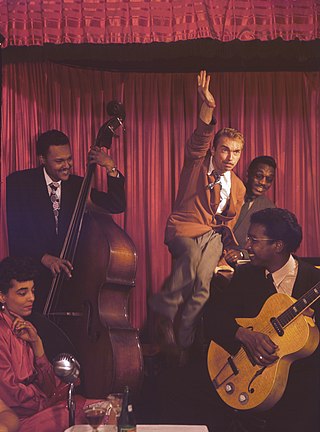
Harry "The Hipster" Gibson, born Harry Raab, was an American jazz pianist, singer, and songwriter. He played New York style stride piano and boogie woogie while singing in a wild, unrestrained style. His music career began in the late 1920s, when, under his real name, he played stride piano in Dixieland jazz bands in Harlem. He continued to perform there throughout the 1930s, adding the barrelhouse boogie of the time to his repertoire.

Callen Radcliffe Tjader Jr. was an American Latin Jazz musician, often described as the most successful non-Latino Latin musician. He explored other jazz idioms, especially small group modern jazz, even as he continued to perform music of Africa, the Caribbean and Latin America.

Robert Henry Timmons was an American jazz pianist and composer. He was a sideman in Art Blakey's Jazz Messengers for two periods, between which he was part of Cannonball Adderley's band. Several of Timmons' compositions written when part of these bands – including "Moanin'", "Dat Dere", and "This Here" – enjoyed commercial success and brought him more attention. In the early and mid-1960s he led a series of piano trios that toured and recorded extensively.

Freddie King was an American blues guitarist, singer and songwriter. He is considered one of the "Three Kings of the Blues Guitar". Mostly known for his soulful and powerful voice and distinctive guitar playing, King had a major influence on electric blues music and on many later blues guitarists.
West Coast jazz refers to styles of jazz that developed in Los Angeles and San Francisco during the 1950s. West Coast jazz is often seen as a subgenre of cool jazz, which consisted of a calmer style than bebop or hard bop. The music relied relatively more on composition and arrangement than on the individually improvised playing of other jazz styles. Although this style dominated, it was not the only form of jazz heard on the American West Coast.

The San Francisco sound refers to rock music performed live and recorded by San Francisco-based rock groups of the mid-1960s to early 1970s. It was associated with the counterculture community in San Francisco, particularly the Haight-Ashbury district, during these years. San Francisco is a westward-looking port city, a city that at the time was 'big enough' but not manic like New York City or spread out like Los Angeles. Hence, it could support a 'scene'. According to journalist Ed Vulliamy, "A core of Haight Ashbury bands played with each other, for each other"
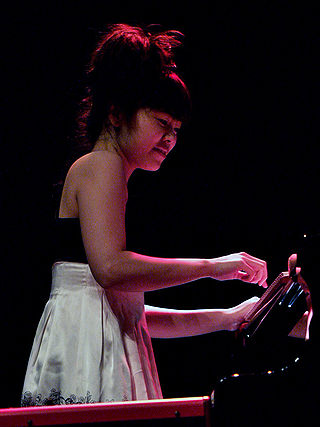
Japanese jazz is jazz played by Japanese musicians, jazz connected to Japan or Japanese culture, or both. The term often refers to the history of jazz in Japan, which has the largest proportion of jazz fans in the world, according to some estimates.

Joseph Leslie Sample was an American jazz, Jazz fusion keyboardist and composer. He was one of the founding members of The Jazz Crusaders in 1960, the band which shortened its name to "The Crusaders" in 1971. He remained a part of the group until its final album in 1991 and also the 2003 reunion album Rural Renewal.

Armando Peraza was a Cuban Latin jazz percussionist and a member of the rock band Santana. Peraza played congas, bongos, and timbales.
The Matrix was a nightclub in San Francisco from 1965 to 1972 and was one of the keys to what eventually became known as the "San Francisco Sound" in rock music. Located at 3138 Fillmore Street, in a 100-capacity beer-and-pizza shop, The Matrix opened 13 August 1965, showcasing Jefferson Airplane, which singer Marty Balin had put together as the club's "house band". Balin had persuaded three limited partners to put up $3,000 apiece to finance the club's opening, giving them 75 percent ownership, while he retained 25 percent for creating and managing it.

John Victor Colla is an American musician, singer and songwriter. He is a founding member of the American rock band Huey Lewis and the News. He has been heavily involved in the San Francisco Bay Area music scene for decades, having been in several other bands, including Rubicon, Sly and the Family Stone, Van Morrison, Sound Hole, and Johnny Colla & The Lucky Devils. Colla has two children, Allison Colla and Ryan Colla.

Steve Khan is an American jazz guitarist.
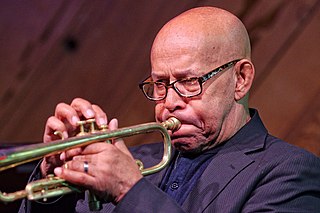
Eddie Henderson is an American jazz trumpet and flugelhorn player. He came to prominence in the early 1970s as a member of pianist Herbie Hancock's Mwandishi band, going on to lead his own electric/fusion groups through the decade. Henderson earned his medical degree and worked a parallel career as a psychiatrist and musician, turning back to acoustic jazz by the 1990s.

Tuck & Patti are an American jazz duo consisting of guitarist William Charles "Tuck" Andress and singer Patricia "Patti" Cathcart Andress.
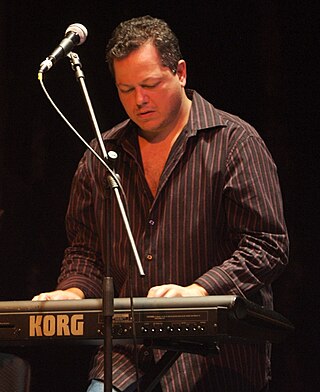
Israel Tanenbaum-Rivera is an American pianist, music producer, composer, arranger and audio engineer who has produced more than 50 albums and participated in over 100 recordings.
Audiophile Records is a record company and label founded in 1947 by Ewing Dunbar Nunn to produce recordings of Dixieland jazz. A very few of the early pressings were classical music, Robert Noehren on pipe organ, AP-2 and AP-9 for example.

The University of California Jazz Ensembles, also known as the UC Jazz Ensembles, UC Jazz, or UCJE, is the student jazz organization founded in 1967 on the University of California, Berkeley, campus. Founded in 1967, it comprises one or more big bands, numerous jazz combos, a vocal jazz ensemble, an alumni big band, and instructional classes. With a mission statement to foster a community for the performance, study, and promotion of jazz at U.C. Berkeley, its Wednesday Night big band provides free concerts every Thursday noon on Lower Sproul Plaza, its various units perform throughout the San Francisco Bay Area including area high schools, travel to collegiate jazz festivals, and perform overseas, and for many years it sponsored the annual Pacific Coast Jazz Festival. It also provides master classes by its instructors and clinics by prominent guest artists. It has nurtured numerous musicians who have become professional jazz musicians and educators. UC Jazz Ensembles is one of three groups, with the Cal (marching) Band and UC Choral Ensembles, forming Student Musical Activities (SMA), a department within Cal Performances on the U.C. Berkeley campus. Its members are primarily U.C. Berkeley undergraduate and graduate students, representing many academic disciplines.

Vince Guaraldi Trio is the debut studio album by American jazz pianist Vince Guaraldi, released in the US by Fantasy Records in September 1956. It was recorded in San Francisco, California, in April 1956.


















